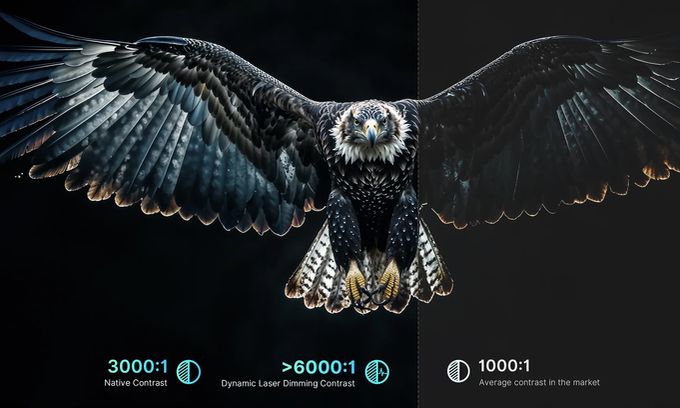Of course, price and image quality are the main characteristics of any TV or projector. In turn, image quality mainly depends on its contrast, brightness and color gamut.
Image quality
Factors:
– ambient light makes the colors of the image dull and faded. Brightness compensates for this negative impact, reducing the dimming requirements;
– color gamut characterizes the number of reproduced colors.
For reference, the display industry uses 3 gamut standards, including Rec.709 for most monitors, DCI-P3 or Hollywood gamut in digital film technology, and Rec.2020 / BT.2020 in 4K digital display for ultra-high-definition TV.
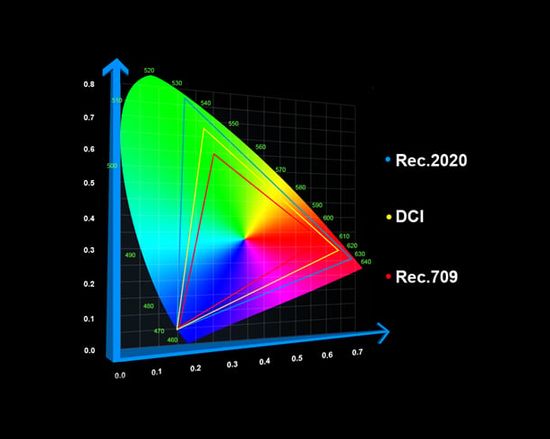
– contrast affects detail in dark scenes and colors saturation.
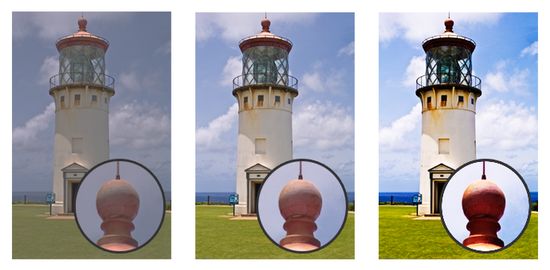
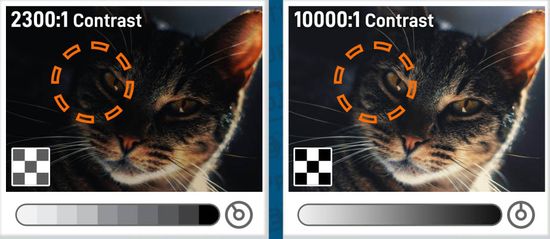
Of course, companies try to present the specs of their products in the most favorable light. Unfortunately, this quite natural desire often distorts reality. The projector brightness perfectly illustrates this problem. In particular, manufacturers use those measurement methods that are optimal given the technology used. As a result, today projectors brightness is measured in:
– ANSI lumens (American National Standards Institute, ANSI IT7.228 standard) – measures the luminous flux at nine points on the screen;
– ISO lumens (1 ANSI Lumen ~ 0.8 ISO lumens, ISO 21118);
– Color Light Output (CLO) and white brightness (Epson 3LCD projectors) – unlike DLP projectors, they are always identical due to the absence of losses on the color wheel;
– LED lumens (1,000 LED lumens ~ 417 ANSI lumens) – are based on the Helmholtz-Kohlrausch effect (the intense saturation of spectral hue is perceived as part of the color’s luminance);
– CVIA lumens (China Video Industry Association) – like ANSI, measures brightness in the 9 points, but also takes into account ambient light and color temperature.
Because of this confusion, some well-known companies choose not to specify brightness at all. Of course, one can philosophical position it as a fee for the free market. But a little unification would be beneficial.
Projector contrast
The situation with contrast is even more confusing. Today, manufacturers use three types of contrast, including native ANSI contrast, full on/off (FOFO) and dynamic contrast. In general, projector contrast is the ratio of the light reflected from an all white and an all black image details. Accordingly, 2,000:1 contrast means that the white image is 2000 times brighter vs black image.
The FOFO method is simple, widely used in the industry, but unreliable. In fact, it measures the ratio between the brightness of a pure white (100 IRE test pattern – ‘full on’), and the brightness of a solid black (0 IRE test pattern – ‘full off’). In this case, for example, a 3,000:1 contrast means that the white is 3000 times brighter than black.
ANSI contrast method (native contrast) uses a single checkerboard pattern of 16 rectangles, including eight white and eight black.
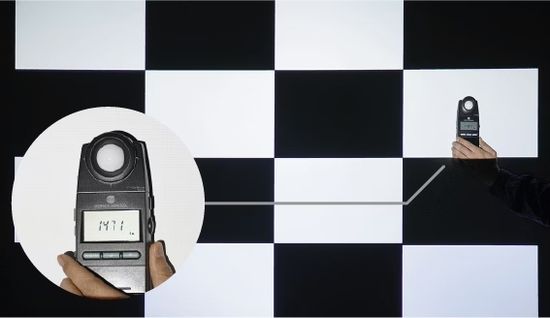
The luxmeter measures the brightness values of all the white and black squares. Then they are averaged. The ANSI contrast ratio is a ratio of the averaged white readings to the black readings.
Today, only LCoS projectors provide excellent contrast due to perfect black. It’s caused by tiny gaps between liquid crystals, which almost completely block light.
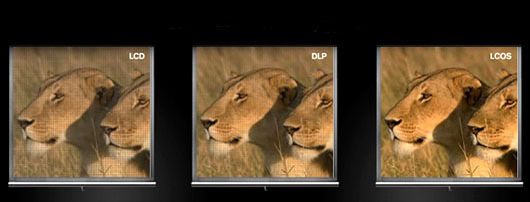
Modern projectors use several versions of them, including:
– JVC – D-ILA (Digital Direct-Drive Image Light Amplifier);
– Sony – SXRD (Silicon X-tal Reflective Display);
– Canon – AISYS (Aspectual Illumination System).
For example, FOFO contrast in specs of new JVC DLA NZ800 and NZ900 reaches 100,000:1 and 150,000:1 at a price of $ 19,000 and $ 30,000, which is clearly not in the mass segment.
Native ANSI contrast vs FOFO
Incorrect measurement of black is the main drawback of the FOFO method. The use of the full black 0 IRE test pattern does not take into account light scatter in the projector’s light engine and lens. But light re-reflection is present in any projector even with high-quality optics and excellent dust protection. ANSI contrast is measured taking into account the partial scattering and re-reflection of the luminous flux inside the zoom lens or light engine. Therefore, ANSI contrast is always lower vs a full black 0 IRE test pattern.
This impact may seem insignificant, but it’s not. For example, the luxmeter or light meter shows 500 units on the 100 IRE test pattern (‘full on’) and 0.05 units for 0 IRE (‘full off’). For reference, a 100 IRE test pattern is the SMPTE color bars, that represents pure white with a luminance level of 100 IRE (Institute of Radio Engineers units).

Accordingly, its contrast reaches 10,000:1. On ANSI checkerboard luxmeter will still measure 500 units for white squares. But the reflected light due to its scattering will increase the black level, for example, to 0.5 units, reducing the contrast to 1,000:1. But such a change in the black level is practically not perceived by our vision. For reference, the little red EXIT sign in a movie theater reduces the effective contrast on the screen by 50% vs perfectly dark.
In fact, manufacturers have ‘invented’ a new redundant and uninformative parameter FOFO contrast, which characterizes a certain ideal process without scattering.
Auto Dynamic Iris
Of course, companies are constantly improving their models, using various methods to increase contrast. In fact, today this list includes Auto Dynamic Iris and AI-based technologies. The Enhanced Black Level (EBL) in Valerion VisionMaster Pro 2 is the most successful example of AI-algorithms. Their operation is similar to local dimming technology in TVs. For reference, Valerion is a subsidiary of AWOL Vision, which originally developed EBL. A few years ago, AWOL Vision renamed itself to AWALL and focused its efforts on the development of Micro LED panels. Moreover, their AWALL CoB MicroLED Display wins in the AV Technology category at InfoComm 2025. Today, their panels are the most affordable on the market. For example, the 75-inch version with 1.2 pixel pitch costs ‘only’ $16,600, which is pleasantly surprising considering the six-figure price tags in this segment.
Auto Irises optimizes light output depending on the average illumination level of the scene. Actually, it opens/closes the iris or changes the laser power. In particular, lumen output decreases in a dark scene, increasing black depth, and increases in a bright scene.
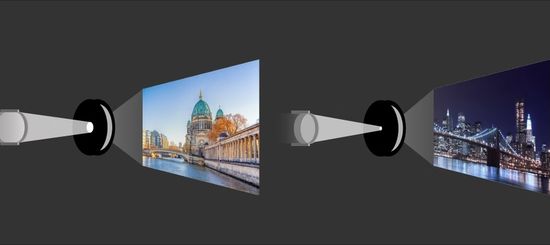
This option is useful, but it should be positioned as an additional function, like auto focus, auto screen adjustment, etc.
Of course, companies are trying to eliminate the confusion with the name. For example, contrast with Auto Irises is usually called dynamic, and AI-based EBL contrast Valerion calls ‘Viewing Contrast’.
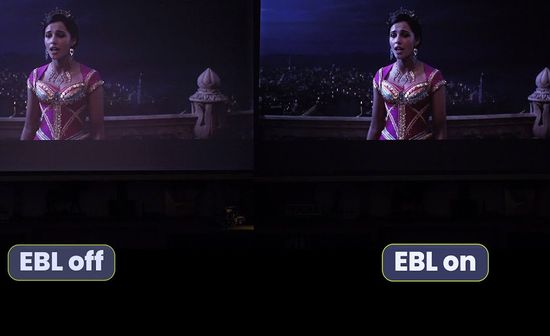
Conclusion
In general, Dynamic contrast with auto iris can be a huge one, which can reach millions. However, this marketing ‘happiness’ is due to the division by almost ‘0’ with an almost closed aperture or min laser power. In fact, it only confirms the presence of the useful Auto Dynamic Irises option in the model. AI-based dynamic contrast is currently only offered in expensive models and can increase contrast to tens of thousands :1.
The usefulness of FOFO is also questionable. In fact, it allows the company to legally indicate a higher contrast in the specs without taking into account the scattering and re-reflection of the light flux.
ANSI contrast is the most honest but, unfortunately, the smallest. For reference, modern Home Theater models offer ANSI rating of 300:1 (average), 700:1 (good) and 1,000:1 (superb). However, some companies with impeccable reputations sometimes specify all types of contrast. For example, the specs of the 6000-lumen commercial Christie DHD600-G include 4,800:1 Dynamic contrast, 1,200:1 Full On/Off, and 250:1 ANSI Contrast. However, Christie’s honesty is also due to the fact that it sells through professional AV equipment resellers who are well versed in this aspect.
The lack of data in specs or the indication of only a huge dynamic contrast may raise well-founded suspicions. But in the near future, companies are unlikely to start quoting an honest, but small ANSI contrast. However, the real native contrast of models from well-known companies with a good reputation usually corresponds to its price.
The video features a discussion between two experts about the native contrast of JVC D-ILA 4K projectors.
